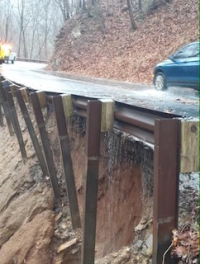Big money on the line as Swain and Graham square off in court
The fight between Swain and Graham counties is growing ever deeper in a dispute marked by lawsuits, counter suits and pleas to the General Assembly over who is entitled to a greater share of payments off the Fontana Dam.
The stakes are high — hundreds of thousands of dollars are on the table — for the two small, rural counties. The row centers over payment in lieu of taxes, or PILT, the money that counties get when federal land holdings erode the property tax base.
Swain and Graham have gotten PILT funds monthly from Tennessee Valley Authority since the Fontana Dam was erected in the early ‘40s.
The formula for calculating how much each county is entitled to was thrown into dispute last year, however. The N.C. Department of Revenue ruled that Graham should get a bigger share since more of the generators were housed on Graham County’s side.
The ruling in Graham’s favor will cost Swain more than $200,000 a year.
But that wasn’t quite enough. Graham also wanted six decades of back payments they felt they were owed — up to $15 million. So in January, they filed suit to get it.
Related Items
Swain County, of course, disagrees. They’ve filed a countersuit, decrying Graham’s claims on a multitude of different grounds, hoping that one will stick. Too many years have passed, Swain argued, and if Graham wanted the money, well, they should have spoken up sooner.
But they didn’t stop there. Swain County has countersued claiming that if anyone was slighted their fair share from TVA and was entitled to a back payments, it should be Swain.
While the latest state formula for calculating PILT payments is based on TVA’s property holdings in each county, that’s not always been the case.
Until 2009, state law said that each county was supposed to get PILT money based on the percentage of lost tax revenue. Since Swain gave up more land when the lake was created — 16 percent of the county, as opposed to Graham’s 2.5 percent — it lost far more tax revenue, and thus should have been getting a greater share of TVA’s PILT money all those years.
“If the Department of Revenue had properly calculated the percentage of lost tax revenue to each county and distributed the PILT revenue accordingly, Swain County would have received substantially more PILT revenue than Graham County received,” said the countersuit.
Swain seeks new formula
Concerned, though, that the counterclaim wasn’t quite enough to solidify their position, Swain County commissioners got together to formulate other tactics.
To add firepower to their arsenal, Swain Commissioners are seeking special legislation from the General Assembly.
Swain wants to change the way PILT payments are calculated. Instead of awarding PILT money based on the value of TVA’s assets — such a which county the generators sit in — it should be based on the value of the land removed from the property tax roles by the lake as a whole.
While Graham’s got more of the hydropower equipment on its side of the county line, Swain has a good deal more land under water than Graham does. Swain stands to benefit substantially.
Swain’s proposed formula for calculating TVA payments is consistent with the PILT formula for national forest service land. Each county gets PILT money based on the acres of land that lie in the national forest and thus have been removed from the tax roles.
Swain also wants the property line between the two counties redrawn. The historical property line was the center of the river channel, but that’s not the boundary currently recognized currently by the state — instead the latest boundary line awards more land to Graham. Swain wants the historical boundary be reinstated, since the more land Swain can claim its lost when the lake was flooded, the more it could get in PILT payments.
Chances?
Currently, Swain doesn’t have anyone to sponsor the legislation in either the Senate or House so face, and could be a tough sell.
In the House, Swain is represented by Rep. Phil Haire, D-Sylva. If Haire chose to take up the cause, he could likely face opposition from Rep. Roger West, R-Marble, who represents Graham.
In the Senate, Sen. Jim Davis, R-Franklin, may opt to steer clear, as he represents both counties.
None have yet weighed in, and Swain commissioners were reluctant to address the matter, saying they had a maneuver in the works it was best not to comment on.
Graham officials are similarly tight-lipped, though they declined to speak because the issue is pending litigation.
“We have approached people in the General Assembly, but we haven’t done anything one way or the other,” said Swain Commissioner David Monteith.
For Graham’s part, their attorney Charles Meeker, who is also the mayor of Raleigh, said the county has rejected all of Swain’s claims outright.
“We don’t believe that they are factually accurate,” said Meeker, and that, he said, was that.
The suits are scheduled to come before the Graham County Superior Court in early April, though Swain has applied for a change of venue. There is, as yet, no timeline for if or when the resolutions will see the General Assembly floor.









